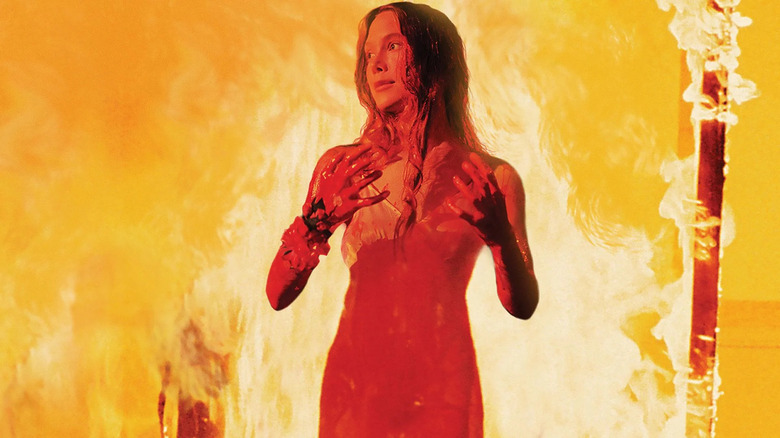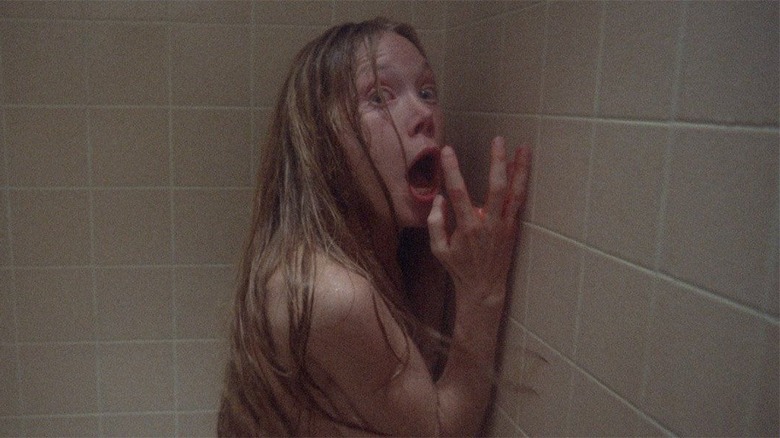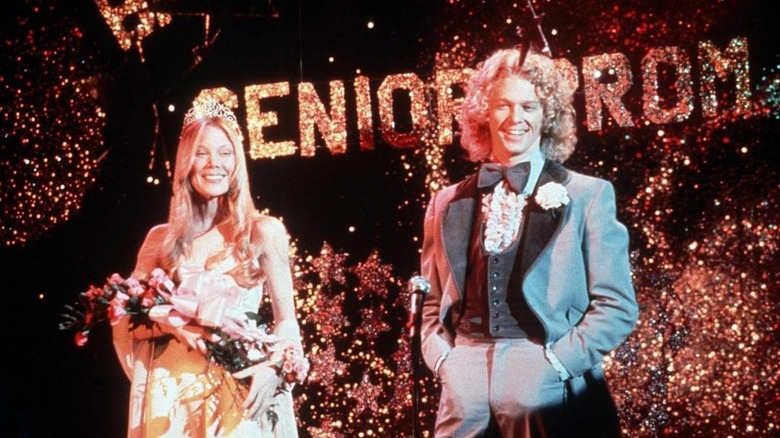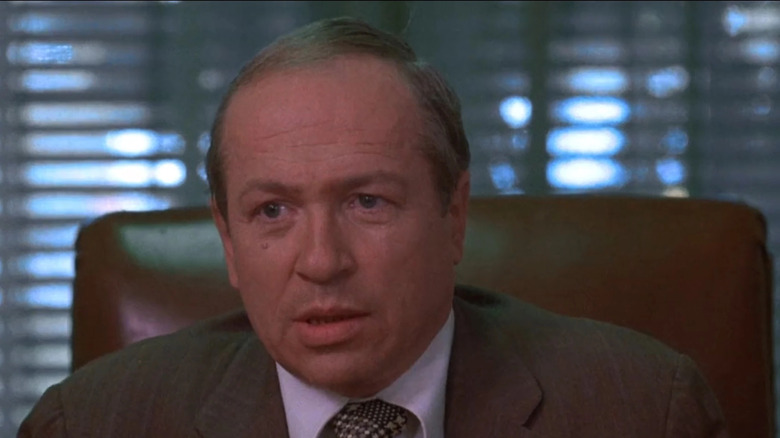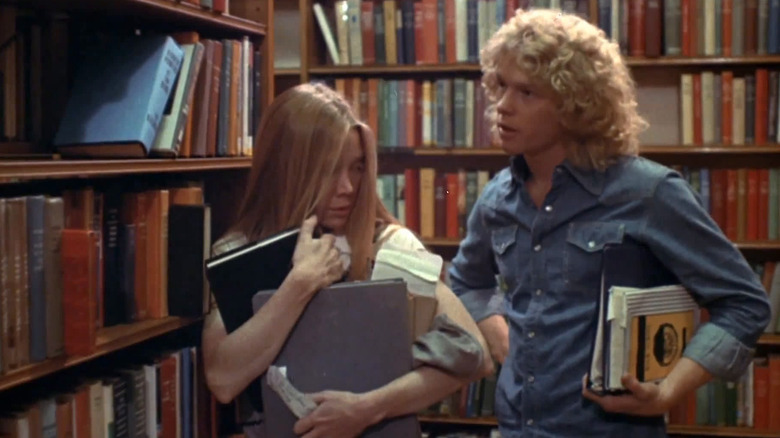The Real-Life Inspiration For Stephen King's Carrie
Stephen King's debut novel followed a 16-year-old high school student named Carrie White who, by the book's beginning, has spent her whole childhood being mistreated by her classmates and treated even worse at home. Things briefly seem to be on the upswing for her when she's asked to the prom by one of the most popular guys in school, even more so when she's crowned homecoming queen. Unfortunately, things come crashing down when one of her classmates dumps a bucket of pig's blood on top of her in front of everyone, provoking Carrie into using her blossoming telekinetic powers to get violent revenge. (And honestly? Good for her. Carrie's earned the right to be a little selfish.)
It's one of the most famous horror stories ever written, and it's since received four movie adaptations, was made into a TV miniseries, and was even turned into a musical (which didn't do well, because of course not). The story works because of how simple it is: Most people have felt like Carrie at one point or another, and most people can relate to Carrie's desire to burn everything down after her tormentors push her too far. This narrative of the bullied kid who snaps and goes crazy is an easy one to latch onto, and the book is often alluded to in explanations for why school shootings happen, despite the fact that most school shooters weren't actually treated like outcasts. When the educational teen drama "Degrassi: The Next Generation" did an episode surrounding a school shooting in 2004, they directly drew from Carrie's prom scene for the pivotal moment where the kid snaps.
Although it's not hard to imagine how Stephen King came up with the idea for "Carrie" — just going to high school would get most people halfway there — most of the inspiration for this novel came from the jobs he had before his writing career fully took off. The inspiration for "Carrie's" opening scene, for instance, came from his brief gig as a high school janitor.
The famous shower scene
The opening scene of "Carrie," which is basically the same in all the movies as it was in the books, has 16-year-old Carrie (played most memorably by Sissy Spacek) getting her first period in the showers after gym class. Because she's both a social outcast and she has a hyper-religious mother who never told her about menstruation, Carrie thinks she's bleeding to death and starts freaking out. The other girls respond by mocking her and throwing tampons at her. Amidst her hurt, fear, and confusion, Carrie unwittingly knocks out one of the lights with the telekinetic powers she didn't know she had.
The scene's so memorable because of how absurdly mean it is, and how every aspect is designed to make you feel as bad for Carrie as possible. Even before things go south for her, there's the extra discomfort of Carrie — already self-conscious about her body — having to shower without any private stall or curtain separating her from the other girls, which even in the '60s wasn't that common. "She wished forlornly and constantly that Ewen High had individual — and thus private — showers," the book reads from Carrie's perspective, "like the high schools at Westover or Lewiston. They stared. They always stared."
When Stephen King was working as a high school janitor cleaning the locker rooms, he noticed that the school's girls' locker rooms had "chrome U-rings with pink plastic curtains attached," unlike the boys' room. As King explained:
This memory came back to me one day while I was working in the laundry, and I started seeing the opening scene of a story: girls showering in a locker room where there were no U-rings, pink plastic curtains or privacy. And this one girl starts to have her period. Only she doesn't know what it is, and the other girls – grossed out, horrified, amused – start pelting her with sanitary napkins ... The girl begins to scream. All that blood!
Carrie was based on two girls from King's childhood
The inspiration for Carrie herself came from two different girls King went to school with. The first was a girl who was bullied mercilessly because "she always wore the same clothes," and the other one was a girl whose mother had a massive crucifix hanging over their living room couch. "If such a gigantic icon had fallen when the two of them were watching TV, the person it fell on would almost certainly have been killed," King wrote. And so, these two real people were combined into a single Carrie White, a girl who was both picked on in school and was stuck with a mother who maybe took her religious beliefs a little too far. The two aspects fit together nicely, as it was Carrie's hyper-religious upbringing that explained why she was stuck wearing the same unflattering outfits each day.
As for the telekinesis? Well, King attributes that to an article he read in LIFE Magazine: "There was some evidence to suggest that young people might have such powers, the article said, especially girls in early adolescence, right around the time of their first — POW! Two unrelated ideas, adolescent cruelty and telekinesis, came together, and I had an idea..."
As for the rest of the novel, it's easy to see how King's job as a teacher reflects in the writing. He'd been teaching at a public high school for two years before "Carrie" was picked up by a publisher, and you can see that in the way the novel constantly jumps into the point of view of the school's staff. One of the book's most memorable characters is Miss Desjardin, who despite initially snapping at Carrie in the opening locker room scene, turns out to be one of the few people who empathizes with Carrie's plight and tries to support her.
Showing the school faculty's perspective
It's by jumping into the adult's points of view that King puts the blame of Carrie's mistreatment not just on a couple of bad students, but on the adults in their lives who fail to adequately step in. Miss Desjardin and Principal Morton both realize they've failed Carrie at the start of the novel and try to make things better, but it turns out to be too little too late.
One subplot in particular that seems like it was directly inspired from King's career as a high school teacher is the conflict between the father of school bully Christine "Chris" Hargensen (played by Nancy Allen in the 1976 adaptation) and Principal Morton. After Chris is forbidden from attending prom as punishment for her treatment of Carrie, she gets her father to come in and threaten Principal Morton into lifting the punishment. Her father's a lawyer who repeatedly comes into the school to bail his daughter out of trouble, much to Morton's frustration.
Most teachers are happy to vent about how often they have to deal with "my child would never" parents, and would immediately recognize Mr. Hargensen as one of them. As a result, the scene where Morton finally pushes back is one of the most cathartic in the book. "I doubt very much if you know the daughter represented in these cards half so well as you think you do," Morton tells him. "If you did, you might realize that it was about time for a trip to the woodshed." It's a scene that serves a clear purpose to the plot — now that Chris can't have her father bail her out of punishment, she's more motivated than ever to get back at Carrie — but it also feels personal for the author. In his years of teaching, King probably had plenty of bullies like Chris Hargensen in his classrooms, and likely met plenty of those kids' parents. This is one of the few moments in the book where someone effectively stands up for Carrie, and she never finds out about it.
Providing a bird's eye view of the school
The smartest decision made when writing "Carrie" was to split it up into several points of view. We don't just follow Carrie's perspective as she's tormented by everyone around her. We follow Sue (played by Amy Irving in the '74 film), a nice popular girl who tries to make things up to Carrie by having her boyfriend go with her to prom. The book hops into her boyfriend Tommy's head, as well Chris' head, as well as Chris' boyfriend's, and some of the teachers. The book also includes snippets from newspapers and biographies written about the events currently happening in the plot; it makes readers feel like they're reading a true crime novel, like they're getting the inside scoop on a real event that happened.
This allows the commentary on American high school culture to be even more potent. There will often be snippets from outside sources where we're told how commentators have debated the motives of certain characters involved. When Tommy (played by William Katt in '74) asks Carrie to the prom, the book treats us to a lengthy excerpt from an in-universe book called "The Shadow Exploded" that covers the widespread incredulity that Tommy wouldn't have been in on Chris' prank. "It is hardly typical of high-school-age adolescents to feel that they have to 'atone' for anything — particularly for an offense against a peer who has been ostracized from existing cliques," an expert in the book is quoted saying.
The passage talks about high school social dynamics like a nature documentary talks about the animal food chain, which feels particularly callous now that the reader's gotten to know Tommy and understand that, like every other character in this story, he's not merely a product of his environment. As much as high school bullying is spoken of like an inevitability, it's through this narrative technique that King pushes readers to realize that it isn't. King used his experience as both a teacher and a former student to pull off one of the most effective anti-bullying novels of all time.
